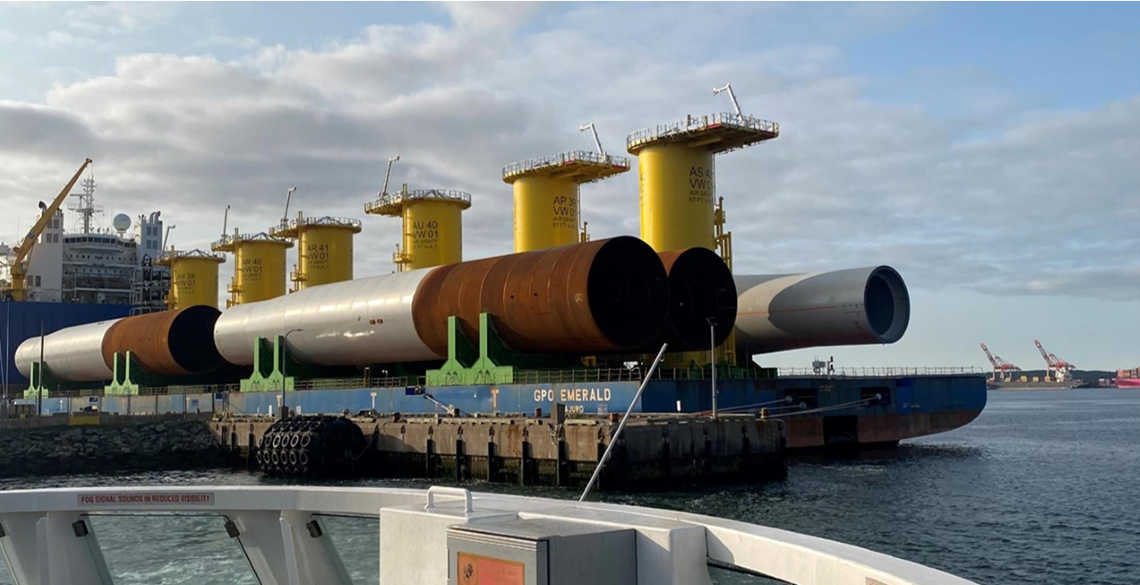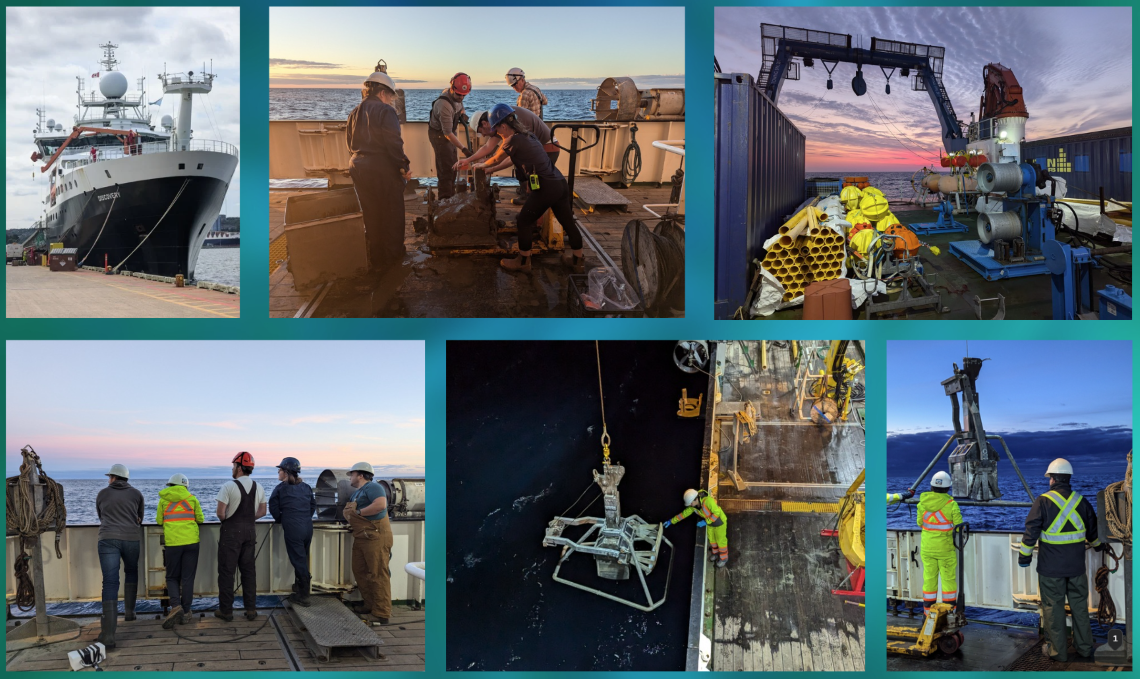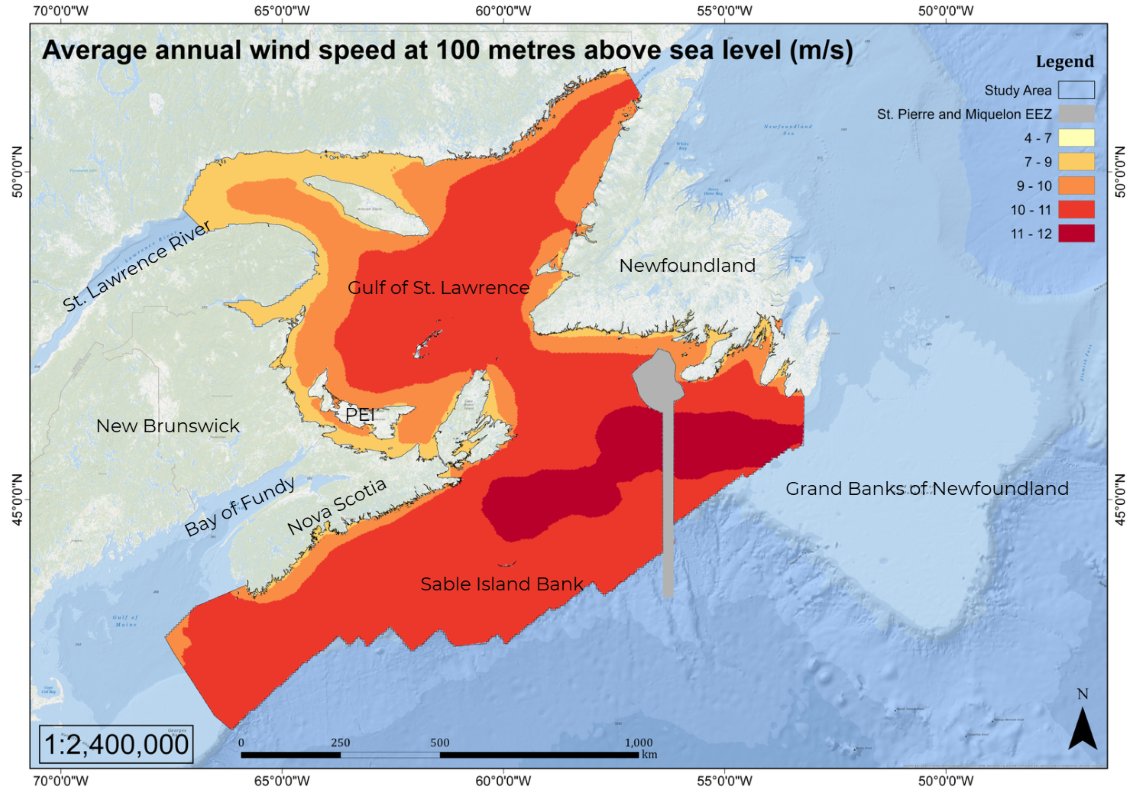With the longest coastline in the world — stretching over 243,000 kilometres — Canada has immense potential to be a significant source of clean offshore wind energy
January 2025
By Madison VanCamp for Simply Science
A nation of shorelines and opportunities
As global interest in clean energy gains momentum, a team of scientists from Natural Resources Canada (NRCan) in Atlantic Canada is advancing offshore wind energy research to harness its vast potential. They’re gathering critical data on underwater processes and seafloor conditions off the coast of Nova Scotia. This is fundamental research, and it's providing an essential piece of the puzzle for identifying suitable locations where wind turbine foundations can be built safely while minimizing effects on coastal communities and marine ecosystems.

Mono piles and wind turbine foundations on a barge in the Halifax Harbour. (photo: Jordan Eamer)
Mapping the seafloor
“This work has been cooking along in the background for a number of years,” says Jordan Eamer, a research scientist with the Geological Survey of Canada (GSC). In 2019, Jordan was assigned a “little offshore wind project” that has since grown into a much larger movement. “It has really started to take off and gain momentum in Canada,” he explains.
Early on, much of Jordan’s work focused on building awareness of the critical role geological insights have in laying the groundwork for offshore wind infrastructure. Offshore wind turbines, often anchored several kilometres from shore and often up to 30 metres below the ocean’s surface, capture the energy of powerful ocean winds to generate sustainable electricity. Many countries including Britain, Germany and Denmark have already tapped into this renewable resource, and Canada is now beginning to explore its potential.
Getting to the bottom of things
Understanding geological features of the seafloor is crucial for the success of sustainable offshore wind projects. For example, the stability of wind turbine foundations depends largely on detailed knowledge of the conditions and characteristics of the seabed floor. Jordan Eamer and his colleagues at the GSC, Laura Broom, a geoscientist, and Alexandre Normandeau, a research scientist, are investigating this research question. Their combined expertise provides a more comprehensive understanding of the geology, seabed dynamics and technological approaches to mapping that is necessary for decision making. Alexandre’s work emphasizes the challenges of trying to map the ever-changing seabed floor when the very nature of water is fluid and sand is always shifting.
“The challenge is that our mapping often consists of just one map, one snapshot in time,” says Alexandre. “What we need to focus on is monitoring underwater processes to see how stable the seabed is and how it changes over time.”

A team of researchers studying the seabed floor off the east coast of Nova Scotia. (photos: Laura Broom)
In 2024, the team conducted research expeditions to regions off the coast of Nova Scotia, including a month-long expedition to map a part of the Middle Bank area, led by Laura. Using multibeam bathymetry — a precise sonar technology for mapping seafloor depth — they gathered crucial data for planning subsequent expeditions to the area and to help evaluate offshore wind suitability. “It requires a lot of time at sea to collect these data,” says Laura. “But what it provides is fundamental for examining the seafloor.” The team examined factors such as seafloor geology, sediment types and movement patterns, all of which influence site selection. They also assessed how wind turbine engineering, construction methods and design might affect the suitability of potential sites.
“The past 14 to 16 months, we’ve been on ships collecting data at sea,” says Jordan. “We’ve been collecting data on the coast, we’ve been mining our existing datasets and processing all of that up in the labs. Everybody’s been going full tilt.” So far, the team has conducted seven expeditions, focusing much of their efforts on the Eastern Scotian Shelf, a part of Canada’s continental shelf east of Nova Scotia. They’re also studying an area farther out at sea, extending from the eastern shore through Sable Island Bank. This work presents the opportunity to collect data in current and potential marine protected zones and will be used to develop baseline data in regions that may hold significant potential for future offshore wind energy development.

Average annual wind speed in metres per second at 100 metres above sea level. Adapted by CanmetENERGY-Ottawa from modelled wind speed data developed by Environment and Climate Change Canada.
Unexpected discoveries and a blast from the past
As well as helping to inform decisions about future offshore wind developments, the geological features uncovered during these expeditions are shedding light on Nova Scotia’s glacial history.
The geological history of Canada’s Atlantic shelf is intertwined with the peak of the last Ice Age around 20,000 years ago. During this period, a thick ice sheet covered the region, shaping the seafloor we see today through erosion, glacial sediment deposition and the creation of unique bedforms. As the ice retreated and sea levels rose, these glacially sculpted landscapes became submerged, leaving behind unique and complex underwater features that NRCan researchers are continuing to explore and understand. This evidence of glacial activity off the coast of Nova Scotia offers a new perspective on the region’s geological past.
“This is the kind of thing that gets a geologist excited,” says Jordan. While these discoveries hold ongoing academic and archeological interest, they are also crucial for assessing the immediate practical matters of the stability and suitability of potential sites for future infrastructure.
“For the management of potential infrastructure or a potential wind farm, there’s implications for the types of sediment you might find,” says Jordan. “Some sediments have more challenging engineering characteristics than others.”
These insights contribute to the various analyses aimed at identifying promising areas for offshore wind energy in Atlantic Canada. Using geographic information system software, researchers evaluate factors such as seafloor geology, wind resources and proximity to high-demand areas to assess the sites.
The results point to several promising areas, including the southern coast of Nova Scotia and areas off the western and southern coasts of Newfoundland. However, much more research and groundwork are needed before any development begins. For example, the effectiveness of wind turbines can be affected by the constantly changing and often unpredictable factors of snow, sea ice and the rise and fall of sea levels, all of which need to be further researched along Canada’s coastline.
From planning to action
Nova Scotia is leading Canada’s offshore wind ambitions. The province plans to open bids for seabed leasing in the coming years, marking a significant step toward tapping into this renewable resource.
While its potential is obvious and strong, offshore wind energy often struggles to capture attention for the simple reason that it’s not something people can see: out of sight, out of mind, as the saying goes. As a result, raising awareness about its benefits — such as decarbonizing Canada’s electricity supply, creating economic opportunities and ensuring development is safe, sustainable and ecologically responsible — is critical as Canada moves closer to realizing its offshore energy potential. Nevertheless, the results to date are impressive and growing: land-based wind turbines accounted for 5.7 percent of Canada’s total electricity generation in 2022 — enough to power about three million typical homes.
Through its strengths in advanced research and its use of the latest technologies, NRCan has an important role to play as Canada charts a course toward a cleaner energy future. On this International Clean Energy Day, you can explore more about Canada’s offshore wind energy potential through the links below.